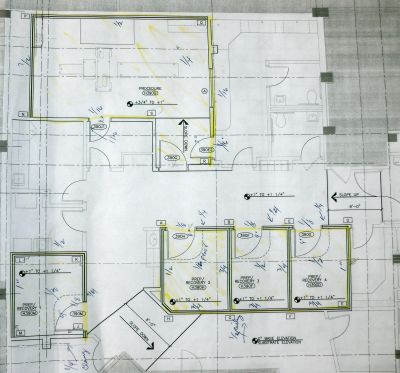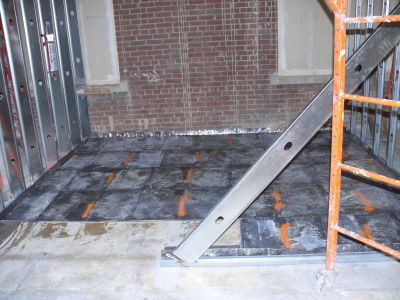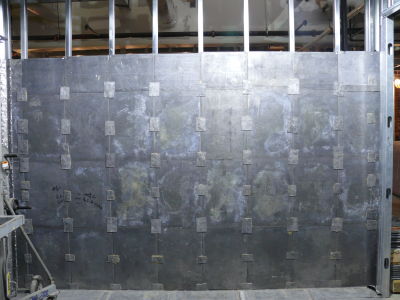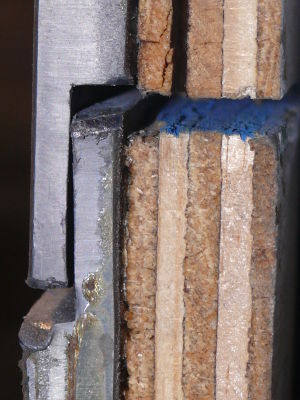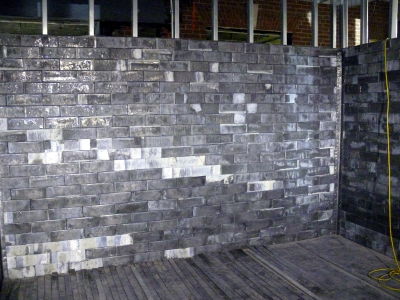The new hospital building hasn’t even been fully occupied yet and I’m already having to defend my territory from poachers.
We were given a room for storing all the new equipment needed to test the x-ray equipment over there. It would be completely impractical to haul stuff back and forth every time I needed to test the x-ray equipment there. Plus the room provides me space to test the portable x-ray and mobile c-arm units too.
Today I wandered over there to find the room and start moving things over. When I found it, I discovered that someone had pasted a carefully crafted ‘Physician Workstation’ label over the sign that said ‘Physics Workroom’.
Was someone trying to fix what they thought was a room labeling mistake, or was someone trying to claim it for themselves? Personally I think it was the latter. Whatever the label, the key I was given unlocked the door, so it’s mine.
Off came the label and in went my stuff.
PET Shielding
Ever wonder what goes into shielding for a PET imaging facility?
No? Well, I’m going to show you anyway.
First you need to find a Qualified Medical Physicist (like me) to develop a shielding design for you. The shielding design gets turned into a set of blueprints for the lead contractor to work with.
Then you need lead. Lots and lots of it.
This is a layer of 1/4″ thick lead sheet lining the floor. The strips cover up the seams between the lead sheets so that there are no gaps. Depending on what’s underneath, the floor may require as much as 1″ of lead.
For the walls, you’ll need stacks of 1/4″ or 1/2″ lead sheet attached to 3/4″ plywood, like these
Thinner lead sheets are usually glued to drywall, but that doesn’t quite cut it for the thicknesses required for PET shielding.
The lead/plywood sheets go up like this
The sheets are also interlocking to eliminate the gap between sheets
Depending on what’s on the other side of the wall, you’ll need bricks too. This is a stack of 1″ interlocking bricks. Sometimes your wall might even need up to 2″ thick bricks.
This is what the brick wall ends up looking like
The bricks are screwed into the metal studs for support. Thicker brick walls require additional support and are usually constructed between two sets of studs.
Equipment testing marathon
This week I did surveys on:
- 2 angio labs
- 4 cath labs (1 biplane)
- 2 EP labs (1 biplane)
- 1 fluoro room
- 4 digital portables
All in preparation for the opening of the new hospital building. I still have two rad/fluoro rooms, 4 c-arms and 3 SPECT/CT scanners left to survey.
I’m pooped.
It will be interesting to see what this month’s radiation badge reading ends up being.
Getting really busy soon
The new hospital tower is getting ready to open. The Siemens people have been busy installing some of the new equipment that’s going in there. Now it’s time to start doing the acceptance testing on the new stuff.
All together, there are about 21 units being installed in the new hospital building. Some of it is existing equipment that’s being moved over, but the bulk of it is new. All of it has to be tested by the end of the year, and that’s all on top of the 25 or so of our already existing systems that I have left to test. At least with the new stuff I don’t have to worry about availability.
I need to clone myself like the Chinese guy did in that AARP commercial.
Studies imported into PACS
Our PACS group gets a lot of patient studies on CDs to be imported into the PACS archive. The other day I was asked if it was possible to split out the study and image counts for these imported studies to get an idea of the imported study volume relative to the total.
Fortunately it turned out to be a relatively easy query since all imported studies use the same prefix for the accession number. After experimenting with a few SQL queries, I managed to come up with data to make this graph showing the fraction of imported studies and images relative to the total volume.

It’s been climbing pretty steadily (something that definitely has not gone unnoticed by the person who does the importing), but is still a pretty small fraction of the total volume.
This will be good stuff to put into my paper.
